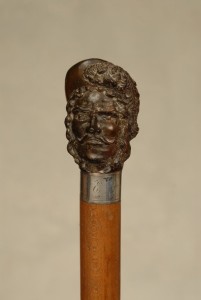
A gutta percha topped walking cane used in the mid-19th century. Congressman Preston Brooks of South Carolina gave Senator Charles Sumner an almost deadly beating with a similar one in May 1856.
This week I learned I need root canal surgery. As the dentist was explaining to me the process for such an ordeal, he mentioned that he would fill the canals of my tooth with Gutta Percha. I was amazed! I had encountered gutta percha while working on my Masters degree in History, but never having anything to do with teeth.
What I knew was that in the mid-19th century men carried canes partially made of gutta percha. The staff of the cane was usually a fine wood topped with an elaborately carved top. The carving could be a dog, a beautiful woman, a noted Greek figure, or anything else that might be considered refined. An artist carved the object from gutta percha, a hard substance made from the sap of plants in Indonesia and Malaysia.
Politicians, bankers, business, and others who considered themselves refined and important strutted about with such a cane, whether needed or not. Most senators and congressmen in Washington sported such a fashion accessory. In May of 1856, Massachusetts Senator and vocal abolitionist Charles Sumner delivered a two-day oratory “The Crime Against Kansas” after events in that state. The prime target of the speech was fellow Senator Andrew Butler of South Carolina.
A distant cousin of Senator Butler served in the US House of Representatives from South Carolina. Congressman Preston Brooks was highly incensed by the perceived insult to Senator Butler. Two days later Brooks walked into the Senate Chamber and began to beat Senator Sumner with his gutta percha topped cane, wreaking extreme injury on the Massachusetts politician. Brooks’ blows were so strong he literally broke the unbreakable cane.
It took Sumner years to recover but he remained in the Senate for eighteen more years often not attending a single session during his term. Brooks on the other hand was fined but not ousted for fear of provoking war between the North and South. Brooks resigned and went back to South Carolina where he died shortly after. Ever since that time, historians link gutta percha with the beating of Senator Sumner.
But the amazing material from trees in South East Asia has had a wide variety of uses over the years. Necklaces and ornaments were carved from the hard rubber-like substance. From 1845 to 1900 golf balls had gutta percha cores. It was used as an insulating material for underwater cables like the Trans-Atlantic telegraph wires were encased in. Pistol grips are still made of the substance.
While medical teams experimented with gutta percha in various ways, it wasn’t until 1959 that the first trials occurred using the substance in root canals. By 1976 gutta percha met International Standards. In a few weeks or months I will be able to tell you how successful it is.
